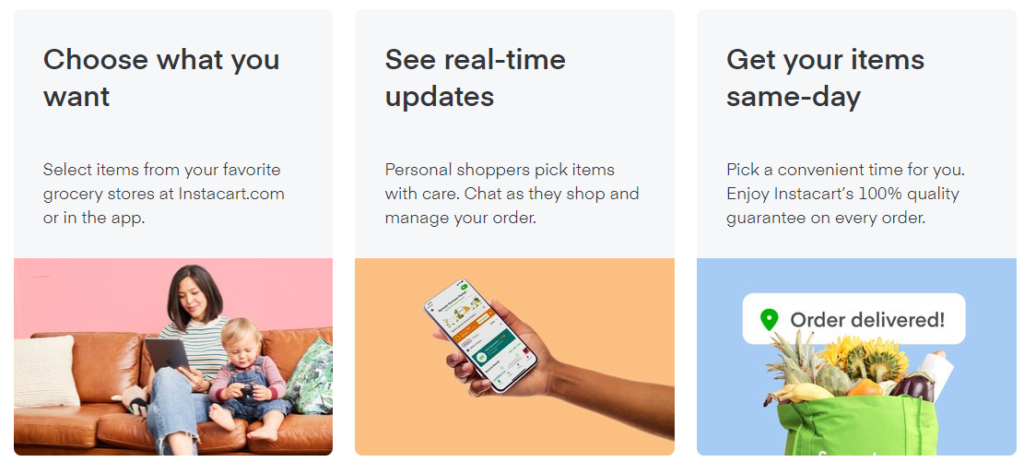Instacart is an American company that operates a grocery delivery and pick-up service in the U.S. and Canada that offers its services via a website and mobile app. The service allows customers to order groceries from the retailers who have participated with the shopping being done by a personal shopper. Instacart was founded in 2012 by Apoorva Mehta, Max Mullen, Brandon Leonardo and is headquartered in San Francisco, California, U.S. Instacart now has more than 10,000+ employees.
Index:
How Instacart works?
Instacart lets you shop from local grocery stores online and then sends a personal shopper to fulfill and deliver your order to you the very same day and the location you have chosen. Unlike, other grocery delivery services the company does not stock in a pile of fresh produce in a massive warehouse instead, their shoppers shop at most grocery stores in your area such as Kroger, Shaw’s, and Costco through its website and then sends your order to one of the company’s part-time employees.
This personal shopper then goes to the store and collects everything on your list and then drives it to you in their own car. There is no delivery cost for the first order and you do not need to be a member to shop from Instacart. But, if you sign up for Instacart Express starting for $99 for the year or $9.99 a month, you will get free delivery for orders more than $35. And this is how Instacart works.

Business Model:
Key Partners:
Instacart includes US grocery chains such as Whole Foods, Fairway Market, H Mart, and Costco among its retail partners and local stores, as well as retailers that provide other specialty products such as wine merchant total wine, beverage retailer Binny’s pet shop Petco.
Key Activities:
The key activities of Instacart are creating an effective technological infrastructure, dealing with local market partners, managing the shopper (delivery partner) workforce, and providing 24×7 customer service.
Key Resources:
There are so many key resources of Instacart; they are its software platform, its IT infrastructure, its team of personal shoppers, and its retail partners.
Value propositions:
Instacart’s greatest value to customers is the ease with which the platform can be used, the efficiency of the company’s delivery service, and its flexibility. Instacart can be accessed on any device and at any time, allowing users to place grocery orders on the go. Deliveries are made quickly when necessary or can be scheduled to arrive at a convenient time as needed by the user, and therefore removing the stress and the more time associated with traditional grocery shopping. The platform also gives the choice to the customers to buy products from several different retailers in a single order, streamlining the shopping process considerably. Instacart also expands the reach of local stores and therefore increasing its audience and ultimately its sales revenue.
Customer Relationship:
When registered on Instacart, users are free and flexible enough to browse products from retailers in their area, place orders, and schedule deliveries without the need to interact with members of the Instacart team. Instacart does provide its customers with support 24×7, providing guides and FAQs on its website. Customers are also able to contact the sales and support department directly via email, phone, and online contact forms. Besides this Instacart also uses different social platforms such as Facebook, Twitter, Pinterest, and Instagram by writing blogs for the customers.
Customer Segments:
The target market of Instacart are customers who do not have the time or mobility to do their own grocery shopping, including busy professionals, the elderly, the disabled, and people without transportation, and customers that require delivery of groceries from several stores at a short interval of time.
Channels:
Instacart’s grocery delivery platform can be accessed by the company’s mobile and desktop websites which is www.instacart.com or through its apps on iOS and Android.
Cost Structure:
Instacart’s principal costs are the development and maintenance of its grocery delivery platforms. Its retention of full-time sales, support and development personnel, operation of its IT infrastructure and data network, and payment of commissions to personal shoppers is the cost structure of Instacart. Instacart cost structure is also related to its rental of office space and utilities for the company.
Revenue Streams:
Instacart generates revenue through various fees imposed on its customers such as delivery charges. Delivery charges are around $5.99 for two hours delivery, scheduled delivery, or more for one-hour delivery, and are limited to orders over $35. Customers are sometimes charged higher delivery fees during busy periods and higher fees for all the orders which are under $35.
Instacart users can also pay $149 for an annual subscription for the Instacart service. Recent reports of Instacart suggests that the company generates around $6.96 per order in Atlanta and $4.29 per order in Chicago, the two largest urban market, while it loses money on orders in New York City and San Francisco’s Bay Area. Instacart also generates a small amount of revenue through the charging of credit card transaction fees from the customers. The revenue of Instacart for the year 2020 was $1.5 billion.
Instacart also makes money via advertisement (Instacart Ads)on its platform where sellers can boost their product in front of customers.

Valuation, expenses, and revenue:
Instacart’s valuation is $39 billion as of 2021. The revenue of Instacart is $1.5 billion for the year 2020. Instacart is not yet publicly listed but the company has clearly announced an IPO. Now, let us see the graph of revenue for the past 5 years:

Investors and funding:
Instacart’s total funding is $2.7 billion. The investors of Instacart are Kleiner Perkins Caufield & Byers, Andreessen Horowitz, Sequoia Capital, Y Combinator, Khosla Ventures, Canaan Partners, etc.
SWOT Analysis
Strength:
- Quality meals and product innovation
- Strong captured marketing and promotional advertisement
- The quick and fast delivery system
- Customer services and pricing range
- Strong brand equity and distribution network
Weakness:
- A low number of outlets
- The need for high technology
Opportunities:
- Instacart delivering convenience
- Demographic changes, as the middle class, can also afford Instacart.
- New trends in the consumer behaviors
- With the lower inflation rate, a business can control their expenses and rates
Threats:
- Direct and Indirect competition
- Regulated pressures, as every year Federal government imposes new laws and policies.

Do Share Your Thoughts:
Do tell us all your thoughts in the comments section below, we look forward to reading all the comments in the section below.
Also, do check the useful Startup Resources and Tools below, and do join our newsletter 📰 for free for more interesting Business Case Studies 💰, Startup Insights 🚀, and Startup founders podcast 🎙️ delivered to your inbox every Sunday morning.
Do follow us:
Related Articles:
- ChaCha Business Model Breakdown: Why ChaCha failed?
- Peloton Business Model: How Peloton makes money?
- Zelle Business Model Breakdown: How Zelle makes money?
- Robinhood Business Model Breakdown: How Robinhood makes money?
- ALDI Business Model Breakdown: How ALDI makes money?
- Afterpay Business Model: How AfterPay makes money?
What is Instacart?
Instacart is an American company that operates a grocery delivery and pick-up service in the U.S. and Canada that offers its services via a website and mobile app. The service allows customers to order groceries from the retailers who have participated with the shopping being done by a personal shopper.
Who founded Instacart?
Instacart was founded in 2012 by Apoorva Mehta, Max Mullen, Brandon Leonardo and is headquartered in San Francisco, California, U.S. Instacart now has more than 10,000+ employees.



